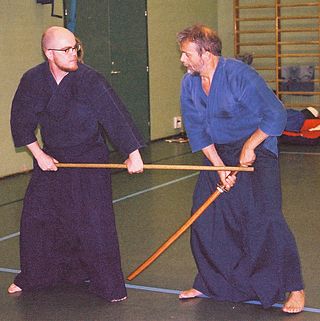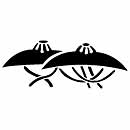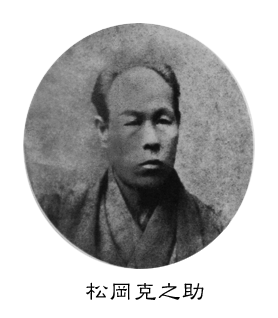Related Research Articles

Iaijutsu (居合術) is a combative quick-draw sword technique. This art of drawing the Japanese sword, katana, is one of the Japanese koryū martial art disciplines in the education of the classical warrior (bushi).

Kenjutsu (剣術) is an umbrella term for all (ko-budō) schools of Japanese swordsmanship, in particular those that predate the Meiji Restoration. Some modern styles of kendo and iaido that were established in the 20th century also included modern forms of kenjutsu in their curriculum. Kenjutsu, which originated with the samurai class of feudal Japan, means "methods, techniques, and the art of the Japanese sword". This is opposed to kendo, which means "the way of the sword" and uses a bamboo sword (shinai) and protective armour (bōgu).

Tenshin Shōden Katori Shintō-ryū (天真正伝香取神道流) is one of the oldest extant Japanese martial arts and an exemplar of bujutsu. It was founded by Iizasa Ienao, who lived near Katori Shrine at the time. The ryū is purported to have been founded in 1447, but some scholars state that it was about 1480.

Naginatajutsu is the Japanese martial art of wielding the naginata (長刀). The naginata is a weapon resembling the European glaive and the Chinese guan dao. Most naginatajutsu practiced today is in a modernized form, a gendai budō, in which competitions also are held.

Iizasa Chōisai Ienao was the founder of Tenshin Shōden Katori Shintō-ryū which is a traditional (koryū) Japanese martial art. His Buddhist posthumous name is Taiganin-den-Taira-no-Ason-Iga-no-Kami-Raiodo-Hon-Daikoji.

Battōjutsu is an old term for iaijutsu (居合術). Battōjutsu is often used interchangeably with the terms iaijutsu and battō (抜刀).
Shinto-ryu can refer to several styles of classical Japanese swordsmanship used by the samurai:

Shintō Musō-ryū, or Shindō Musō-ryū (神道夢想流),a most commonly known by its practice of jōdō, is a traditional school (koryū) of the Japanese martial art of jōjutsu, or the art of wielding the short staff (jō). The technical purpose of the art is to learn how to defeat a swordsman in combat using the jō, with an emphasis on proper combative distance, timing and concentration. The system includes teachings of other weapon systems which are contained in Shintō Musō-ryū as auxiliary arts. The school is sometimes abbreviated as SMR.

Yagyū Shingan-ryū (柳生心眼流), is a traditional school (koryū) of Japanese martial arts. Different styles of Yagyū Shingan-ryū, such as Heihojutsu and Taijutsu, assert different founders, Takenaga Hayato and Araki Mataemon respectively, but they all go back to Ushū Tatewaki, referred to in some historical scrolls as Shindō Tatewaki, who taught a system based on Sengoku-period battlefield tactics, that was called Shindō-ryū.

Kashima Shinden Jikishinkage-ryū, often referred to simply as Jikishinkage-ryū or Kashima Shinden, is a traditional school (koryū) of the Japanese martial art of swordsmanship (kenjutsu). The school was founded in the mid-16th century, based upon older styles of swordsmanship like Yoru no Hikari Ryū, and is one of the few ancient Japanese martial arts schools still existing today.

Shindō Yōshin-ryū (新道楊心流), meaning "New Willow School" is a traditional school (ko-ryū) of Japanese martial arts, teaching primarily the art of jūjutsu. The first kanji of the name originally translated into "新=New", but in the mainline branch the kanji for "new" was eventually changed into the homophonic "神=sacred". The name of the school may also be transliterated as Shintō Yōshin-ryū, but the koryu tradition should not be confused with the modern school of Shintōyōshin-ryū which is unconnected.
Ittō-ryū (一刀流), meaning "one-sword school", is the ancestor school of several Japanese Koryū kenjutsu styles, including Ono-ha, Mizoguchi-ha, Nakanishi-ha, Kogen, Hokushin, Itto Shoden and even Mugai Ryu.The style was developed by Itō Ittōsai Kagehisa.
Kashima Shintō-ryū (鹿島新當流) is a traditional (koryū) school of Japanese martial arts founded by Tsukahara Bokuden in the Muromachi period (c.1530).

Kamiizumi Nobutsuna,, born Kamiizumi Ise-no-Kami Fujiwara-no-Hidetsuna, was a samurai in Japan's Sengoku period famous for creating the Shinkage-ryū school of combat. He is also well known as Kamiizumi Isenokami which was his name as a samurai official for a period of time.
Shintō Musō-ryū, or Shindō Musō-ryū (神道夢想流) is a traditional (ko-ryū) school of the Japanese martial art of jōjutsu, the art of handling the Japanese short staff (jō). The art was created with the purpose of defeating a swordsman in combat using the jō, with an emphasis on proper distance, timing and concentration. Additionally, a variety of other weapons are also taught.
Maniwa Nen-ryū (馬庭念流) is a traditional school (koryū) of Japanese martial arts founded in 1591 by Higuchi Matashichirō Sadatsugu. Matashichirō was a student of Nen-ryū, and founded Maniwa Nen-ryū after receiving inka from Akamatsu Gion. It is currently headed by the 25th headmaster, Higuchi Sadahito.
Tenshinsho Jigen Ryu Hyōhō (天眞正自源流兵法) is a koryu specializing in iaijutsu and kenjutsu (swordsmanship) founded by Tose Yosazaemon Osamune around the Eiroku Era. The system also teaches Yawara (柔), Naginata (長刀) Sōjutsu (槍術) and Nagamaki (長巻) as part of the curriculum. The current headmaster of the Tenshinsho Jigen Ryu is the 16th (30th) sōke Takahashi Tamon (髙橋多聞).

Risuke Ōtake full name Ōtake Risuke Minamoto no Takeyuki, was a Japanese martial artist. He was a long time shihan of Tenshin Shōden Katori Shintō-ryū bujutsu, which he learned as a disciple of the previous teaching master Hayashi Yazaemon (1892-1964) from the time he entered the school in 1942 at the age of 16. In 1967, when Otake-sensei was 42 years old, he received gokui kaiden, the highest level of attainment in the tradition, and at the same time became the school's teaching master. He lived and taught in rural location near Narita city, in Chiba Prefecture of Japan. The teachings of Tenshin Shōden Katori Shintō-ryū were designated an Intangible Cultural Asset of Chiba Prefecture in 1960, with Ōtake designated as guardian of the tradition.
Tose Yosazaemon Osamune was a goshi from Hitachi province in Japan. He is credited with founding the Tenshinsho Jigen Ryu around the Eiroku Era.
References
- ↑ Skoss, Diane (2006-05-09). "A Koryu Primer". Koryu Books. Retrieved 2007-01-01.
- 1 2 3 4 5 6 7 8 Skoss, Diane (1997). Koryu Bujutsu Classical Warrior Traditions of Japan Vol.1. Koryu Books. p. 63. ISBN 1-890536-04-0.
- ↑ Friday, Karl F.; Seki, Humitake (1997). Legacies of the Sword: The Kashima-Shinryu and Samurai Martial Culture. University of Hawaii Press. ISBN 978-0824818791.
- 1 2 3 4 5 6 7 Skoss, Diane (1997). Sword & Spirit Classical Warrior Traditions of Japan Vol.2 . Koryu Books. p. 70. ISBN 1-890536-05-9.
- ↑ Watatani Kiyoshi, Yamada Tadashi (1969). Bugei Ryuha Daijiten (武芸流派大事典) (Large Encyclopedia of Martial Arts) (in Japanese). Shin Jinbutsu Ourai Sha (人物往来社).